I toyed a program together which could help you to study the intricacies of virtual bases. It prints the class hierarchy under I as a digraph suitable for graphiviz ( http://www.graphviz.org/ ). There's a counter for each instance which helps you to understand the construction order as well. Here's the programm:
#include <stdio.h>
int counter=0;
#define CONN2(N,X,Y)\
int id; N() { id=counter++; }\
void conn() \
{\
printf("%s_%d->%s_%d\n",#N,this->id,#X,((X*)this)->id); \
printf("%s_%d->%s_%d\n",#N,this->id,#Y,((Y*)this)->id); \
X::conn(); \
Y::conn();\
}
#define CONN1(N,X)\
int id; N() { id=counter++; }\
void conn() \
{\
printf("%s_%d->%s_%d\n",#N,this->id,#X,((X*)this)->id); \
X::conn(); \
}
struct A { int id; A() { id=counter++; } void conn() {} };
struct B : A { CONN1(B,A) };
struct C : A { CONN1(C,A) };
struct D : B { CONN1(D,B) };
struct E : B,C { CONN2(E,B,C) };
struct F : C { CONN1(F,C) };
struct G : D,E { CONN2(G,D,E) };
struct H : E,F { CONN2(H,E,F) };
struct I : G,H { CONN2(I,G,H) };
int main()
{
printf("digraph inh {\n");
I i;
i.conn();
printf("}\n");
}
If I run this (g++ base.cc ; ./a.out >h.dot ; dot -Tpng -o o.png h.dot ; display o.png), I get the typical non-virtual base tree:

Adding enough virtualness...
struct B : virtual A { CONN1(B,A) };
struct C : virtual A { CONN1(C,A) };
struct D : virtual B { CONN1(D,B) };
struct E : virtual B, virtual C { CONN2(E,B,C) };
struct F : virtual C { CONN1(F,C) };
struct G : D, virtual E { CONN2(G,D,E) };
struct H : virtual E,F { CONN2(H,E,F) };
struct I : G,H { CONN2(I,G,H) };
..results in the diamond shape (look at the numbers to learn the construction order!!)

But if you make all bases virtual:
struct A { int id; A() { id=counter++; } void conn() {} };
struct B : virtual A { CONN1(B,A) };
struct C : virtual A { CONN1(C,A) };
struct D : virtual B { CONN1(D,B) };
struct E : virtual B, virtual C { CONN2(E,B,C) };
struct F : virtual C { CONN1(F,C) };
struct G : virtual D, virtual E { CONN2(G,D,E) };
struct H : virtual E, virtual F { CONN2(H,E,F) };
struct I : virtual G,virtual H { CONN2(I,G,H) };
You get a diamond with a different initialization order:

Have fun!


